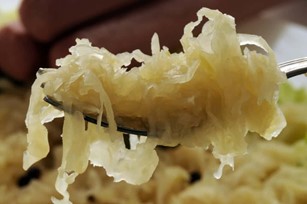Sauerkraut & Bullfrogs Boiled in Vinegar
Robert Duncan-Enzmann
In 2011 construction workers in Colorado (USA) dug down into a one-time pond now filled with sediments. At a level dated to about 45,000 years ago, bones of numerous mammoths were found. Curiously the bones were more-or-less in separate bundles. Many bones had cut and scrape marks as though the meat had been in part cut away. Even more curious were hefty rocks associated with each bundle of bones. The date is outrageous. Conventional archaeology knows no humans were in the Americas until about 12,000 BC.
Note: The Colorado discovery would be an excellent addition to Forbidden Archaeology, a book largely regarded by conventional archaeologists as writings by erudite charlatans. It is excellent and has impeccable research reports. I venture marinated mastodon is what was discovered in Colorado. But imagine! People in the Americas ca 43,000 BC!! (See Forbidden Archaeology. 1993. Michael Cremo & Richard Thompson. Bhakti Vedanta: Los Angeles.)
Ca. 9450-9370 BC, Allerød-II, to cold, dry Inter-Allerød II/III little ice age cultures include the Creswellian, England, Azilian, France & Iberia, Tjongerian, Scandinavian, Romellian, Italian.
Ca. 9500-9450 BC Stellmoor (vinegar) Site, Germany, Stellmoor hunters used: tanged-flint Zonhoven arrowheads, harpoons, scrapers, burins, needles, weaver’s battens &, calendrics (usually engraved on reindeer ribs) often with engravings describing spinning and weaving.
Marination Woodland Deer construct of the Stellmoor observations.
In one peat bog, a wooden post had a reindeer’s skull on top. I have always contended this indeed marked the location of between 600 to 700 reindeer sunk in a pond and that this had nothing whatsoever to do with sacrifice. The skull on a pole marked the location of a meat locker. I found that more than a few reindeer were associated with stones.
See: Mesolithic Settlement of Northern Europe.1936. J. Clark. Cambridge Univ.
See: Vor 20,000 Jahren. 1962. A. Rust. Karl Wachholtz Neümunster: Germany
In Siberia of the 1930s, we shared a delightful treat – ‘twas said to be 20,000-year-old mammoth meat. We got ours before the dogs had a chance to eat all of it. It tasted like vinegar, which kills germs. I note that the Siberians also prepare sourdough, which is more vinegar-like than alcoholic. A naturally marinated baby Mammoth that fell through a pingo is what we ate after the guides chased away our dogs.
Note: These were the years when we lived in Peking and periodically traveled via Trans-Siberian Diplomatic Wagon Listed trains to and from England and Central Europe. Thank God, my mother, Florence-Rebecca Goodman, whose twin sister was named Rebecca-Florence, did insist that we “Get out of this place” (madhouse Europe) and live in Bath, Maine from whence she came.
British ‘Limies’ German ‘Krauts’
That lime juice prevents scurvy is nearly universally known. That German science took another, and just as effective path is scarcely mentioned. It’s told by reliable sources that large German diesel-electric cargo submarines equipped with saddle tanks having cruising ranges of +35,000 miles, steeped sauerkraut in the engine room. Our best data from such subs are verbal allegations concerning the so-called Fifth Submarine. There were five. One sunk in the North Sea, one sunk on the Atlantic Equator where Ballard dived to recover its cargo of gold, one surrendered at Portsmouth with a ton of bomb-quality uranium, and one went somewhere Number five, “The Fifth Submarine,” super-stretched, commandeered by Brandenbergers, a WWII German Foreign Legion fed-up-with Nazis that escaped in 1945 with over 300 men, women & children on board.
Stewing sauerkraut in their engine room goes to show that vinegar marination, which is one bacteriological step past beer brewing, may have preceded beer brewing by millennia.
(See: Critical Mass. 2004. Carter Plympton Hydrick. Whitehurst: Flemington, NJ)
Note: We know of no written material concerning Dr. Schonland, an Afrikaaner [Boer] and world-class physicist, who probably masterminded the design of England’s atom bomb and at the same time directed S. Africa’s uranium yellow-cake to the U.S.A and England. I met him in an unusual way. Interested in age determination with mass spectrographs, I got acquainted with physicists at the Witwatersrand University in Johannesburg. I sat reading Die Burger, and Oss Wah Brandwach Publications, feet on the table. Someone behind me said: “Will nie rook?” (Care for a cigarette?)
“Nier Danke ek nie rook nie!” (No thanks, I don’t smoke)
In Afrikaans: “Americans can’t speak Afrikaans!!!”
In Afrikaans: “Well, a few of the important things like: Asseblief var ist die Kaffe Kammer Bioskope – Please, where’s the Tea Room Bioscope?”
We were soon on very friendly terms. We shared, among many things, a keen interest in S. W. Africa’s 1916 Strong Children’s trek to Tanganyika, where, zig-zagging thousands of miles, sniping all the way, they joined von Lettow Vorbeck. They fought with him till 1918 when they surrendered honorably.
They were curiously tough, steeped in ethics and traditions of the “Brandwach” – wagon train sentinels who compare with America’s Oregon trail pioneers. My favorite trek-train was one with 60 men and grown-up boys, over 200 women, and well over 700 children, most of whom survived. They trudged most of the way barefoot. Mother had relatives in that group.
Pickles, Acorns, and Olives
That pickles may have descended from sauerkraut steeping, which was invented by an unknown and therefore, an un-honored genius, is easily imagined.
Yet another giant culinary step forward is acorn-steeping to make acorn bread which we suggest was practiced at least by 31,000 BC Aurignacian Rhone-Rhine-Danube peoples.
Olive steeping is later, perhaps 10,500 BC, in uncomfortably cold Dryas II and Allerød centuries, impelling northerners southward where olive trees grow.





